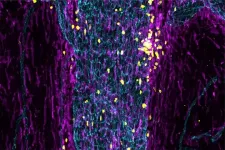'Virtual anatomy' imaging yields new insight into ancient platypus fish
2021-01-27
(Press-News.org) The inner ear of a 400 million-year-old 'platypus fish' has yielded new insights into early vertebrate evolution, suggesting this ancient creature may be more closely related to modern-day sharks and bony fish than previously thought.
A team of scientists from the University of Birmingham in the UK, and institutions in China, Australia and Sweden, used 'virtual anatomy' techniques, including MicroCT scanning (using x-rays to look inside the fossil) and digital reconstruction to examine previously unseen areas within the braincase of these mysterious fossils.
They discovered the fish, called Brindabellaspis stensioi and nicknamed 'platypus fish' because of its long beak, has an inner ear which is surprisingly compact in construction. Its closely connected components resemble the inner ears of modern jawed vertebrates such as sharks and bony fishes. Some features of it also appear very similar to a human's inner ear. The team's analysis is published in Current Biology.
The fish belongs to a group called placoderms, a class of armoured fish which thrived for 60 milllion years of the early Palaeozoic era, between 420 and 360 million years ago. Most placoderms have less complex inner ear structures, with a large sac, called a vestibule, placed in the centre and separating all the other components.
The Brindabellaspis stensioi fossils were discovered in Australia in the later part of the 20th century. Several examples were dug out of limestone rocks in an ancient reef near the Brindabella Moutains on the border of New South Wales. The specimens were unusually well preserved, giving palaeontologists a rare opportunity to examine inside the brain cavity. Their early analysis led them to conclude these fish were closely related to primitive, jawless fishes that first appeared some 500 million years ago.
The more recent analysis, however, challenges assumptions that placoderms were a distinct group and supports the possibility that they, in fact, contained the origins of modern jawed vertebrates.
Joint first author on the paper, Dr Sam Giles, of the University of Birmingham's School of Geography, Earth and Environmental Sciences, explains: "The inner ear structure is so delicate and fragile that it is rarely preserved in fossils, so being able to use these new techniques to re-examine specimens and discover this wealth of new information is very exciting."
She adds: "This fossil has revealed a really intriguing mosaic of primitive features and a surprisingly modern inner ear. We don't yet know for certain what this means in terms of our understanding of how modern jawed vertebrates evolved, but it's likely that virtual anatomy techniques are going to be a critical tool for piecing together this fascinating jigsaw puzzle."
INFORMATION:
The research was funded by the Chinese Academy of Sciences, the National Natural Science Foundation of China, the Australian Research Council, the Swedish Research Council, the Knut and Alice Wallenberg Foundation and the Royal Society.
ELSE PRESS RELEASES FROM THIS DATE:
2021-01-27
BOSTON -- For the first time, scientists have identified the individual neurons critical to human social reasoning, a cognitive process that requires us to acknowledge and predict others' hidden beliefs and thoughts. A team of neuroscientists at Massachusetts General Hospital (MGH) and Massachusetts Institute of Technology (MIT) had a rare look at how individual neurons represent the beliefs of others by recording neuron activity in patients undergoing neurosurgery to alleviate symptoms of motor disorders such as Parkinson's disease. Their findings are published in Nature.
The researchers were studying a very complex social cognitive ...
2021-01-27
What The Study Did: This study among patients in Italy suggests that despite virological recovery, a sizable proportion of patients with COVID-19 experienced respiratory, functional or psychological conditions months after hospital discharge.
Authors: Mattia Bellan, M.D., Ph.D., of Università del Piemonte Orientale in Novara, Italy, is the corresponding author.
To access the embargoed study: Visit our For The Media website at this link https://media.jamanetwork.com/
(doi:10.1001/jamanetworkopen.2020.36142)
Editor's ...
2021-01-27
What The Study Did: In this observational study of about 7,300 adults with laboratory-confirmed COVID-19 in a New York health system, a schizophrenia spectrum diagnosis was associated with an increased risk of death after adjusting for demographic and medical risk factors. Mood and anxiety disorders weren't associated with increased risk of mortality.
Authors: Donald C. Goff, M.D., of New York University Langone Medical Center in New York, is the corresponding author.
To access the embargoed study: Visit our For The Media website at this link https://media.jamanetwork.com/
(doi:10.1001/jamapsychiatry.2020.4442)
Editor's Note: The article includes conflict of interest disclosures. Please see ...
2021-01-27
What The Study Did: Researchers evaluated the association between the pandemic and clinical research and development by studying the initiation of oncology clinical trials over time.
Authors: Elizabeth B. Lamont, M.D., M.S., M.MSc., of Acorn AI by Medidata, a Dassault Systèmes Company, in Boston, is the corresponding author.
To access the embargoed study: Visit our For The Media website at this link https://media.jamanetwork.com/
(doi:10.1001/jamanetworkopen.2020.36353)
Editor's Note: The article includes conflict of interest disclosures. Please see the article for additional information, including other authors, author contributions and affiliations, conflict of interest and financial ...
2021-01-27
New findings on the brain and inner ear cavity of a 400-million-year-old platypus-like fish cast light on the evolution of modern jawed vertebrates, according to a study led by Dr. ZHU Youan and Dr. LU Jing from the Institute of Vertebrate Paleontology and Paleoanthropology (IVPP) of the Chinese Academy of Sciences.
The study was published in Current Biology on Jan 27.
Back in 1960s, Paleontologist Dr. Gavin C. Young found several fossils of a long-beaked fish, a type of placoderm, in the Burrinjuck limestones in Australia. He named the fish Brindabellaspis stensioi, and other people jokingly dubbed it "platypus fish" because of its long ...
2021-01-27
Alzheimer's disease, multiple sclerosis, autism, schizophrenia and many other neurological and psychiatric conditions have been linked to inflammation in the brain. There's growing evidence that immune cells and molecules play a key role in normal brain development and function as well. But at the core of the burgeoning field of neuroimmunology lies a mystery: How does the immune system even know what's happening in the brain? Generations of students have been taught that the brain is immunoprivileged, meaning the immune system largely steers clear of it.
Now, researchers at Washington University School of Medicine in St. Louis believe they have figured out how the immune system keeps tabs on what's going on in the brain. Immune ...
2021-01-27
What makes cancer cells different from ordinary cells in our bodies? Can these differences be used to strike at them and paralyze their activity? This basic question has bothered cancer researchers since the mid-19th century. The search for unique characteristics of cancer cells is a building block of modern cancer research. A new study led by researchers from Tel Aviv University shows, for the first time, how an abnormal number of chromosomes (aneuploidy) -- a unique characteristic of cancer cells that researchers have known about for decades -- could become a weak ...
2021-01-27
Biologists believe they are one step closer to a long-held goal of making a cheap, widely available plant a source for energy and fuel, meaning one of the next big weapons in the battle against climate change may be able to trace its roots to the side of a Texas highway.
Researchers at The University of Texas at Austin, HudsonAlpha Institute for Biotechnology, the U.S. Department of Energy (DOE) and other institutions have published a complex genome analysis of switchgrass, a promising biofuel crop.
The team tied different genes to better performance in varying climates across North America, which now gives scientists a road map for breeding ...
2021-01-27
A high proportion of survivors of Ebola experienced a resurgence in antibody levels nearly a year after recovery, a new University of Liverpool study has found.
Published today in Nature, the finding hints that hidden reservoirs of virus could exist long after symptoms ease and has implications for monitoring programmes and vaccine strategies.
When a person is infected with Ebola virus, their body produces antibodies to fight the disease. Antibody concentrations peak and then decline slowly over time, providing the body with some degree of immune protection ...
2021-01-27
Researchers have discovered a novel and druggable insulin inhibitory receptor, named inceptor. The latest study from Helmholtz Zentrum Muenchen, the Technical University of Munich and the German Center for Diabetes Research is a significant milestone for diabetes research as the scientific community celebrates 100 years of insulin and 50 years of insulin receptor discovery. The blocking of inceptor function leads to an increased sensitisation of the insulin signaling pathway in pancreatic beta cells. This might allow protection and regeneration of beta cells for diabetes remission.
Diabetes mellitus is a complex disease characterized by the loss or dysfunction of insulin-producing beta cells in the islets of Langerhans, ...
LAST 30 PRESS RELEASES:
[Press-News.org] 'Virtual anatomy' imaging yields new insight into ancient platypus fish




